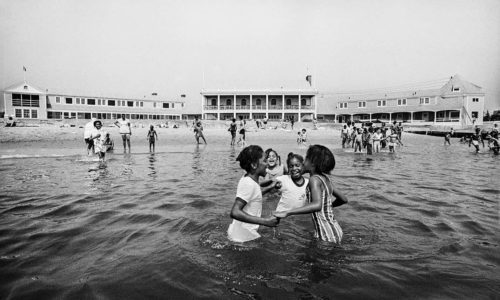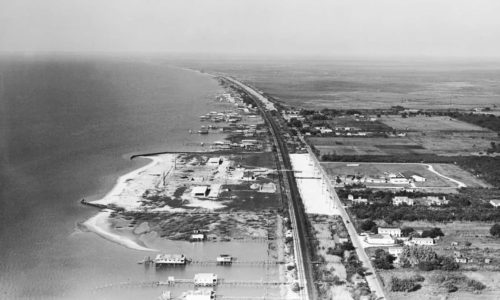America’s segregated shores: beaches’ long history as a racial background
Share
Explore Our Galleries
Breaking News!
Today's news and culture by Black and other reporters in the Black and mainstream media.
Ways to Support ABHM?
By Andrew W. Kahrl, The Guardian
For decades officials imposed regulations to restrict African Americans’ use of public beaches – and the fight for equal access is far from over.

Summers have long been America’s most segregated season. Nowhere is this more evident than along the nation’s beaches and coasts, one of the chief destinations for vacationers and pleasure seekers, and a perennial site of racial conflict and violence. The infamous 1919 Chicago race riot, which lasted seven days and claimed 38 lives, began on the shores of Lake Michigan, when white youth gang members stoned to death a black teenager named Eugene Williams after he had accidentally drifted across a color line in the water. In its aftermath, African Americans learned to avoid the city’s lakefront. As a child, black Chicagoan Dempsey Travis remembers, “I was never permitted to learn to swim. For six years, we lived within two blocks of the lake, but that did not change [my parents’] attitude. To Dad and Mama, the blue lake always had a tinge of red from the blood of that young black boy.”
In the decades that followed, local governments across the US enacted a host of policies and practices designed to segregate places of outdoor leisure by race and effectively exclude people of color

from public beaches. In the south, those methods were quite explicit. Coastal cities such as Norfolk, Virginia, Charleston, South Carolina, and Miami, Florida, prohibited African Americans from stepping foot on any of their public beaches, and for years ignored blacks’ demands for public beaches of their own. Whites’ indifference to the health and humanity of black communities often had deadly consequences. Throughout the Jim Crow era, shockingly high numbers of black youth drowned each summer while playing in dangerous, and unsupervised, bodies of water. When white officials did respond to black demands for beaches and parks of their own, they invariably selected remote, polluted, often hazardous, locations. In Washington DC, officials designated Buzzard’s Point, a former dumping ground located downstream from a sewage plant, as an appropriate location for the city’s “colored” bathing beach. In New Orleans, it was a remote site on Lake Pontchartrain, 14 miles from downtown, surrounded on both sides by fishing camps that dumped raw sewage into the lake. One health official described the waters offshore as “grossly contaminated” and wholly unfit for bathing….
But aside from these modest gestures, little was done to address the underlying causes of summertime segregation and recreational inequality. In recent decades, fiscally distressed cities have slashed funding for outdoor recreation programs for disadvantaged children, and closed or sold off public parks, beaches and swimming pools in poorer neighborhoods, while affluent communities continue to employ the same tactics for keeping “undesirables” out of their parks and off their shores. Earlier this spring, officials in Westport, Connecticut, dramatically increased parking fees and slashed the number of passes sold to non-residents at its public beach. The move came after locals complained about the growing numbers of outsiders there the previous summer. In the exclusive community of Palos Verdes Estates, California, a gang of wealthy local whites (known as the “Lunada Bay Boys”) has been waging a decades-long campaign of terror against non-residents, especially African Americans, who seek access to the town’s public beach. Local residents have subjected visitors to beatings and

assaults, racist epithets, sexual harassment, dog attacks, death threats, property destruction and vandalism, all with the tacit approval of local law enforcement. Officials in this and other affluent beachfront communities in Los Angeles, meanwhile, have for years thwarted attempts by the city’s regional transit authority to offer direct bus routes from black and brown inner-city neighborhoods to the beach. As a result, it is common to find black children living in Los Angeles who have never even seen the Pacific Ocean, much less spent a day on its shores.
Like schools and neighborhoods, the persistence of racial separatism in places of play didn’t just happen by chance. Nor does it, as some might claim, simply reflect people’s personal preferences. It is the result of public policies and private actions that, by design, aimed to segregate bodies of water by race and allow whites to claim the most desirable outdoor spaces to themselves. Many of these policies and practices remain in effect today. Undoing them is critical to making public space in America truly public, and to ensuring that all Americans enjoy the basic human right to leisure and recreation.
Read the full article here.
Read more Breaking News here.
View galleries from America’s Black Holocaust here.









Comments Are Welcome
Note: We moderate submissions in order to create a space for meaningful dialogue, a space where museum visitors – adults and youth –– can exchange informed, thoughtful, and relevant comments that add value to our exhibits.
Racial slurs, personal attacks, obscenity, profanity, and SHOUTING do not meet the above standard. Such comments are posted in the exhibit Hateful Speech. Commercial promotions, impersonations, and incoherent comments likewise fail to meet our goals, so will not be posted. Submissions longer than 120 words will be shortened.
See our full Comments Policy here.